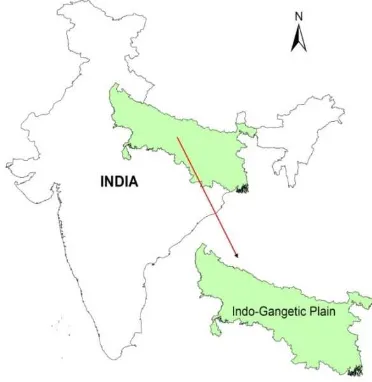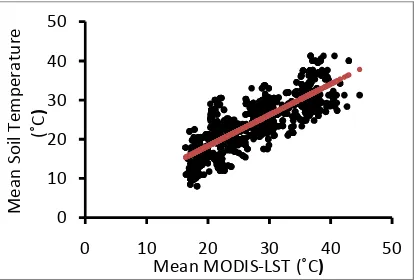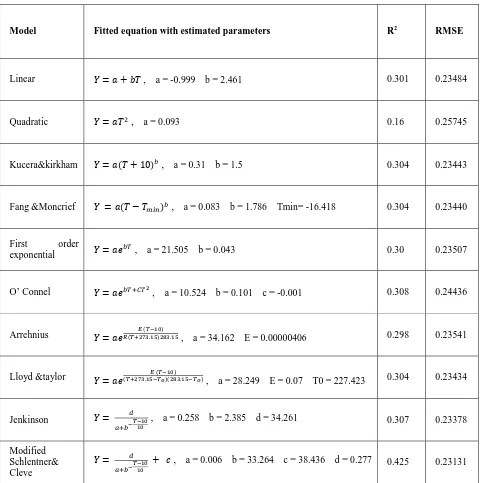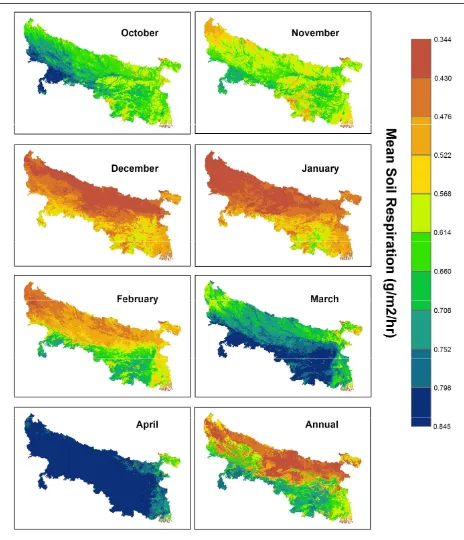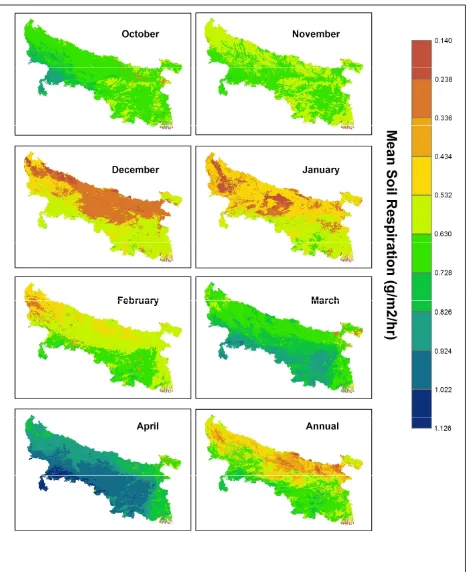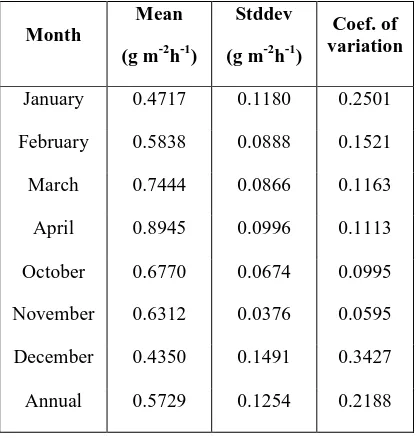Available online at www.ijrat.org
24
Spatio-Temporal Estimation of Soil Respiration
for Indo-Gangetic Plain using Remote Sensing
Ravikant
1and M. Kudrat
21
Defence Terrain Research Laboratory, DRDO, Delhi, India
2Indian Institute of Remote Sensing, ISRO, Dehradun, Uttrakhand, India
Email: ravikant.mahto@gmail.com1, kudrat_isro@yahoo.co.in2
Abstract-Soil respiration, a process of CO2 addition from terrestrial ecosystems to the atmosphere, is highly
sensitive to temperature change. Various relations showing dependence of soil respiration on soil temperature has been established. It is possible to obtain land surface temperature (LST) from Remote Sensing. This remotely sensed LST can be used as a soil temperature to estimate soil respiration. Present study shows the use of remote sensing in quantification and up-scaling soil respiration to large scale through modeling. Best fitted model relating soil respiration with soil temperature was found using in-situ data collected over period of two years (May 2007 to April 2009) in a part of Indo-Gangetic plain followed by soil respiration estimation for Indo-Gangetic plain using remotely sensed MODIS derived LST. For this, various temperature dependent linear, power, exponential and logistic models of soil respiration were fitted on the field data (Monthly mean soil respiration - Monthly mean soil temperature) and analyzed using regression analysis. MODIS derived monthly mean LST were calibrated using field monthly mean soil temperature to obtain MODIS derived monthly mean soil temperature images. Modified Schlentner and Cleve model fitted well compared to other models whereas linear model also showed the good predictability. These best fitted models were applied on MODIS derived monthly mean soil temperature images of Indo-Gangetic plain to estimate the monthly mean soil respiration. Study showed that the soil respiration is positively correlated with soil temperature and remote sensing has potential to monitor soil respiration at local, regional and global scale.
Index Terms: Soil respiration, Temperature, Climate change, Model, Remote Sensing, Land surface temperature, Indo-Gangetic plain.
1. INTRODUCTION
Soil is the largest global pool of terrestrial carbon and is at least three times larger than the atmospheric carbon pool [1,2].Soil respiration, a critical process, defined as the production of carbon dioxide by microorganisms (hetrotrophic respiration) and plant roots, normally refers to the total carbon dioxide efflux at the soil surface. Soil respiration is considered as the second largest source of CO2
efflux between terrestrial ecosystems and the atmosphere, and is a major pathway of global carbon cycling [3,4,5,6,7]. It plays a critical role in regulating atmospheric CO2 concentration. Soil
respiration is very sensitive to environmental
changes such as temperature change. Soil
temperature increase, amplifies the microbial and root activity thus raises the soil respiration rate [8,9,10,11]. Elevated rates of soil respiration could significantly impact the concentration of CO2 in
atmosphere with potential feedbacks to climate change [2,4,12,13,14,15]. With global warming, role of soil as carbon sink could change to a major
carbon source [16,17,18,19]. So, as a key factor influencing soil CO2 efflux, the temperature
sensitivity of soil respiration has gained considerable attention of the research community. Different models have been developed and are being developed relating soil respiration with the soil temperature. Models such as exponential or Arrhenius equations, linear models, quadratic models, logistic models, and empirical models shows temperature dependence of soil respiration [11,20].
25
soil respiration on large scale and complexityinvolved in scaling local soil respiration to large
scale [27,25,24], not much work has been done using remote sensing for its estimation. For large scales, temperature is more influencing factor than other environmental factors for soil respiration [28,29,30,31]. Since remote sensing is used to obtain land surface temperature (LST), this LST can
substitute soil temperature to estimate soil
respiration. Present study aims to model CO2
emission rate versus temperature from known in-situ data collected over a part of study area and to scale up CO2 emission rate to regional scale using remote
sensing.
2. MATERIAL AND METHOD
2.1 Study area characteristics and concerns
Indo-Gangetic plain (21°32'20.56"N -
30°24'41.64"N and 77°05'40.39"E - 89°50'12.55"E) (Fig. 1), spread along river Ganga between Himalaya and Deccan plateau, In our study area it covers the states of Uttar Pradesh, Bihar, Jharkhand, West Bengal and is among the most fertile alluvial plain of the world. In this region, seasonal temperature varies widely with scorching summer from April to June, rainy season from July to September and cold winter from November to February. With wheat as the main crop in the west and rice in the east, it is the most intensively cultivated zone of India. Maize, Mustard, Barseem, Sorghum, Sugarcane, several pulses and vegetables are other important crops. Its agriculture production supports major population of South Asia [32]. Rapid population growth and reduction in resources has put stress on this region to support current as well as future demands. Agricultural soil is one of major source of greenhouse gases. Crop rotation system, irrigation, extensive use of fetilizers, burning of crop residue, conventional tillage practice and burning of diesel fuel practiced over decades in this region has lead to direct impact on greenhouse gases emission such as CO2, N2O and CH4 [33]. Though increased
CO2 concentration increases the crop yield but
associated temperature rise and precipitation may result in overall production decline [32]. Long term experiments in this region has already shown decline in the productivity and is a cause of concern [33]. Global warming could lead increased soil respiration rates in this region. Higher soil respiration rates will further increase the CO2 concentration in atmosphere
and may result in overall productivity decline of this
region. This decline productivity will affect the many million people of South Asia. So, in this climate change scenario, it becomes imperative to study and monitor soil respiration in Indo-Gangetic plain.
2.2 In-situ data collection
Data for CO2 emission rate (soil respiration) and soil
temperature at 78 locations in different districts, viz., Saharanpur, Haridwar, Muzaffarnagar, Meerut, Bagpat and Ghaziabad of Uttar Pradesh from May probe. Soil temperature measurements were made at 5 cm depth. Data collected was processed to obtain
monthly mean CO2 emission rate and monthly mean
soil temperature. The final data had twenty five locations with monthly mean soil CO2 emission rate
(g m-2hr-1) and monthly mean soil temperature (˚C).
2.3 Model selection
The dependency of soil respiration (CO2 emission
Available online at www.ijrat.org
26
plot between monthly mean soil respiration andmonthly mean soil temperature. Five hundred fifty observations were used for analysis. The scatter plot showed the non-linear relationship between them that has also been seen in many previous studies. Ten models (Table 1) were tested on the data using the linear / Non-linear regression of SPSS
17(statistical software) with Marquardt-Levenberg algorithm that minimizes the sum of squares of differences between the dependent variable values in the equation models and the observed values to determine the parameters of the equation. The equations fitted are presented in Table 1.
2.4 MODIS Land surface temperature (LST) data
The MODIS Land surface temperature - MOD11A2 product, a global LST (8 day composite), 1km x 1km resolution, was used to extract MODIS-derived monthly mean LST (˚C) for each month from May 2007 to April 2009 for study area.
2.5 Calibration of MODIS monthly mean LST data using field temperature data
Using latitude and longitude value of twenty five locations, MODIS monthly mean LST values were extracted for each month from May 2007 till April 2009. The extracted MODIS monthly mean LST was then correlated with in-situ data of monthly mean soil temperature using linear regression analysis. The monthly mean soil temperature data were found to be linearly related to MODIS monthly mean LST (Fig. 2) with coefficient of determination (R2) equals to 0.646. The equation obtained is given below:
Monthly mean soil temperature = 0.789×MODIS monthly mean LST + 2.48
The above obtained linear equation was then used to calibrate the MODIS monthly mean LST imagery.
2.6 Soil respiration for Indo-Gangetic plain
Based on the statistical regression analysis obtained best suited equation was used to determine soil respiration of the Indo-Gangetic plain. Modified Schlentner & Cleve equation was finally selected to apply on the monthly mean soil temperature imageries to generate the monthly mean soil respiration imageries for each month. Mean of preceding year and succeeding year months were taken to generate monthly mean respiration images of Indo-Gangetic plain. Annual mean soil respiration image were also generated using annual mean temperature image which is generated by taking the mean of all monthly mean temperature images. In same manner linear model was also used to generate monthly mean and annual mean soil respiration images because of its simplicity and predictability. Monthly mean soil temperature for the month of May, June, July, August and September were ignored because of cloud cover. Sequential flow of methodology is depicted in Fig. 3.
3. RESULTS
of R2 value 0.425 and minimum RMS error 0.23131
gm-2hr-1. However because of simplicity and reasonably higher R2 value 0.301 and lower RMS error 0.23484 gm-2hr-1, linear model was also selected. Quadratic model showed inferiority to the other models. Models such as first order exponential given by Kucera & Kirkham (1971), Fang & Moncrief (2001), O’Connel (1990), Lloyd & Taylor (1994) and Jenkinson (1990) are better than quadratic and produced the almost same soil
respiration predictability with nearly same
coefficient of determination of regression (R2 = 0.30). Scatter plots linear and Modified Schlentner & Cleve model fitted on data are shown in Fig. 4.
0
3.2 Spatio-Temporal Variation of Mean Soil Respiration in Indo – Gangetic Plain
Both models showed that CO2 efflux from surfaces
of Indo-Gangetic plain varies seasonally with lower CO2 effluxes during winters and higher effluxes
during summers. This seasonal variation can be
Fig. 4. (A) Fitted Modified Schlentner & Cleve model and (B) Fitted Linear Model
A
Temporal Variation of Mean Soil Gangetic Plain
efflux from surfaces Gangetic plain varies seasonally with lower effluxes during winters and higher effluxes during summers. This seasonal variation can be
depicted from spatial pattern of monthly mean soil respiration for Indo-Gangetic plain derived from Modified Schlentner &
model are presented as follow in Fig. 5 and 6 respectively.
Fig. 3.Sequential flow of Methodology
4. (A) Fitted Modified Schlentner & Cleve model and (B) Fitted Linear Model
B
27
depicted from spatial pattern of monthly mean soilGangetic plain derived from Cleve (1985) and Linear presented as follow in Fig. 5 and 6
Available online at www.ijrat.org
28
Table 1. Fitted models with estimated parameters, coefficient of determinations and the RMSEModel Fitted equation with estimated parameters R2 RMSE
Linear ܻ = ܽ + ܾܶ , a = -0.999 b = 2.461 0.301 0.23484
Quadratic ܻ = ܽܶଶ , a = 0.093 0.16 0.25745
Kucera&kirkham ܻ = ܽ(ܶ + 10) , a = 0.31 b = 1.5 0.304 0.23443
Fang &Moncrief ܻ = ܽ(ܶ − ܶ) , a = 0.083 b = 1.786 Tmin= -16.418 0.304 0.23440
First order
exponential ܻ = ܽ݁
் , a = 21.505 b = 0.043 0.30 0.23507
O’ Connel ܻ = ்ܽ݁ା்మ , a = 10.524 b = 0.101 c = -0.001 0.308 0.24436
Arrehnius ܻ = ܽ݁ೃ(శమళయ.భఱ)మఴయ.భఱಶ (షభబ) , a = 34.162 E = 0.00000406 0.298 0.23541
Lloyd &taylor ܻ = ܽ݁(శమళయ.భఱష)(మఴయ.భఱష)ಶ (షభబ) , a = 28.249 E = 0.07 T0 = 227.423 0.304 0.23434
Jenkinson ܻ = ௗ
ାష
షభబ భబ
, a = 0.258 b = 2.385 d = 34.261 0.307 0.23378
Modified Schlentner& Cleve
ܻ = ௗ
ାష
షభబ భబ
29
Available online at www.ijrat.org
30
31
3.3 Mean Soil Respiration
It was found that monthly mean soil respiration predicted from Modified Schlentner & Cleve model (1985) was less than predicted by linear model with lesser deviations as well. Table 2 and Table3 shows the summary of the monthly mean soil respirations from January to December and for a year for Indo-Gangetic plain generated by Modified Schlentner & Cleve (1985) and linear model respectively.
4. DISCUSSION
Soil respiration is highly dependent on
temperature[7,11] and shows the seasonal pattern of higher values in hot season and lower values in cold
season[3,34]. The relationship between soil
respiration and temperature is nonlinear as observed in previous studies and temperature alone has been used to model the soil respiration. Soil temperature alone could explain the total variance of soil respiration, up to 40% of variance of soil respiration was explained by temperature alone with the help of the models used. The results of the present study are in agreement with that of the Peng et. al.[35], Jones and Cox[17] and Bond-Lamberty and Thomson[25], the reason could be that as the soil temperature and soil moisture correlated with each other, it is possible that relationship between soil respiration and soil temperature is confounded by soil moisture. Also contribution of other factors cannot be ruled out.
Remote sensing is the powerful technique and it provides a lot of information related to land, ocean and atmosphere. Using satellite based land surface temperature (LST), soil respiration for Indo-Gangetic plain was extrapolated to understand the spatial pattern of soil respiration over the Indo-Gangetic plain. The results are in agreement with that of Tamai [36], Fang and Moncreif [11] and Wang et al. [37]. Wang et al. [38] also reported that the model of Schlentner and Van Cleve showed minimum RMS error, we also found that this model showed minimum RMS error.
Most of the studies done on soil respirations are limited to small area and with global concern related with soil respiration it is mandatory to quantify it for larger areas. And hence, remote sensing could be a better technique to estimate the soil respiration over large areas.
5. CONCLUSION
Present study showed that the soil respiration is positively correlated with soil temperature. Remote sensing can be used effectively for quantification and up-scaling soil respiration at local, regional as well as at global scale. Present study will provide light to mitigate global warming and climate change. And more studies using the technique of remote sensing are needed in order to improve the estimation of soil respiration. With the introduction of soil moisture and biophysical parameter along with temperature better prediction is expected. Soil Table 3. Summary of monthly mean soil
Available online at www.ijrat.org
Though soil temperature is the dominant influencing factor for the soil respiration, but there are other factors which can influence it. Most of the factors that influences soil respiration can be derived from remote sensing. Attempt has to be made to model including moisture and soil properties for large area. Provided other data sets like soil moisture content Jackson, R. B. (2006): Predicting the temperature dependence of microbial respiration in soil: A
continental-scale analysis. Global
biogeochemical cycles, 20, GB3026,
doi:10.1029/2005GB002644.
[2] Wiriyatangsakul, S.; Chidthaisong, A.;
Tripetchkul, S.; Limtong P. (2006): Effects of moisture and temperature on respiration in tropical forest and agricultural soils. Kasetsart J. (Nat. Sci.), 40, pp. 395-409.
[3] Tang, X. L.; Zhou, G. Y.; Liu, S. G.; Zhang, D. Q.; Liu, S. Z.; Li, J.; Zhou, C. Y.; (2006):
Dependence of soil respiration on soil
temperature and soil moisture in successional forests in southern china. Journal of integrative plant biology, 48, pp. 654−663.
[4] Fenn, K.M.; Malhi Y.; Morecroft M. D. (2010): Soil CO2 efflux in a temperate deciduous forest:
Environmental drivers and component
contributions. Soil biology & biochemistry, 42, pp. 1685-1693.
[5] Zheng, ZM.; Yu, GR.; Fu, YL.; Wang, YS.; Sun,
XM.; Wang, YH. (2009): Temperature sensitivity of soil respiration is affected by prevailing climatic conditions and soil organic carbon content: A trans-China based case study. Soil biology & biochemistry, 41, pp. 1531-1540. [6] Subke, JA; Bahn, M. (2010): On the ‘temperature
sensitivity’ of soil respiration: Can we use the immeasurable to predict the unknown?. Soil biology & biochemistry, 42, pp. 1653-1656. [7] Risk, D.; Kellman, L.; Beltrami, H. (2002):
Carbon dioxide in soil profiles: Production and temperature dependence. Geophysical research letters, 29, 10.1029/2001GL014002.
[8] Pietikäinena, J.; Petterssona, M.; Bååth, E. (2005): Comparison of temperature effects on soil respiration and bacterial and fungal growth rates. FEMS Microbiology Ecology,52(1), pp. 49–58
[9] Bond-Lamberty, B.; Thomson A. (2010):
Temperature-associated increases in the global soil respiration record. Nature, 464, pp. 579–582. [10]Lloyd J.; Taylor J.A. (1994): On the temperature
dependence of soil respiration. Functional Ecology, 8, pp. 315–323.
[11]Fang, C.; Moncreif, J. B. (2001): The dependence of soil CO2 efflux on temperature. Soil biology & biochemistry, 33, pp. 155-165.
[12]Xia, J.; Han, Y.; Zhang, Z.; Zhang, Z.; Wan, S.; (2009): Effects of diurnal warming on soil respiration are not equal to the summed effects of day and night warming in a temperate steppe. Biogeosciences, 6, pp. 1361-1370.
[13]Reichstein, M.; Beer, C. (2008) Soil respiration across scales: The importance of a model–data integration framework for data interpretation. J. plant nutr. soil sci., 171, pp. 344-354.
[14]Jones, C.D.; Cox, P.; Huntingford, C. (2003): Uncertainty in climate–carbon-cycle projections
associated with the sensitivity of soil
respirationto temperature. Tellus 55B, 2, pp. 642–648.
[15]Reynolds, L.L.; Johnson, B.R.; Pfeifer-Meister, L.; Bridgham, S.D. (2015): Soil respiration response to climate change in pacific northwest prairies is mediated by a regional mediterranean climate gradient. Global Change Biology, 21, pp. 487–500.
[16]Cox, P.M.; Betts, R.A.; Jones, C.D.; Spall, S.A.; Totterdell, I.J. (2000): Acceleration of global warming due to carbon-cycle feedbacks in a coupled climate model. Nature, 408, pp.184 -187. [17]Jones, C.D.; Cox, P.M. (2001): Constraints on the temperature sensitivity of global soil respiration from the observed interannual variability in atmospheric CO2. Atmospheric
Science Letters, doi:10.1006/asle.2001.0041
[18]Reichstein, M.; Rey, A.; Freibauer, A.;
Tenhunen, J.; Valentini, R.; Banza, J.; Casals, P.; Cheng, Y.; Grunzweig, J.M.; Irvine, J.; Joffre, R.; Law, B.E.; Loustau, D.; Miglietta, F.; Oechel, W.; Ourcival, J-M.; Pereira, J.S.; Peressotti, A.; Ponti, F.; Qi, Y.; Rambal, S.; Rayment, M.; Romanya, J.; Rossi, F. (2003): Modeling temporal and large-scale spatial variability of soil
respiration from soil water availability,
33
Global Biogeochemical Cycles, 17, 0, XXXX,doi:10.1029/2003GB002035, 2003
[19]Wang, W.; Guo, J.; Oikawa, T. (2007):
Contribution of root to soil respiration and carbon balance in disturbed and undisturbed grassland communities, northeast China. J. Biosci., 32, pp. 375–384.
[20]Tuomi, M.; Vanhala, P.; Karhu, K.; Fritze, H.; Liski, J. (2008): Heterotrophic soil respiration— Comparison of different models describing its temperature dependence. Ecological Modelling, 2II , pp. 182–190
[21]Chen, S.T.; Huang, Y.; Zou, J.W.; Shi, Y.S.; Lu, Y.Y.; Zhang, W.; Hu Z.H. (2012): Interannual variability in soil respiration from terrestrial ecosystems in China and its response to climate quantifying the net CO2 flux of the kuparuk river basin, Alaska. Global Change Biology, 6 (suppl. 1), pp. 160-173
[23]Hashimoto, S.; Carvalhais, N.; Ito, A.;
Migliavacca, M.; Nishina, K.; Reichstein, M. (2015: Global spatiotemporal distribution of soil respiration modeled using a global database. Biogeosciences, 12, pp. 4121–4132.
[24]Huanga, N.; Heb, J.S.; Niud, Z. (2013):
Estimating the spatial pattern of soil respiration in Tibetan alpine grasslands using Landsat TM images and MODIS data. Ecological Indicators, 26. pp. 117–125.
[25]Bond-Lamberty, B.; Thomson, A. (2010): A
global database of soil respiration data. Biogeosciences, 7, pp. 1915–1926.
[26]Zhou, T.; Shi, P.; Hui, D.; Luo, H. (2009): Global pattern of temperature sensitivity of soil
heterotrophic respiration (Q10) and its
implications for carbon-climate feedback. Journal
Of Geophysical Research, 114, G02016,
doi:10.1029/2008JG000850, 2009
[27]Olofsson, P.; Lagergren, F.; Lindroth, A.; Lindström, J.; Klemedtsson, L.; Eklundh, L. (2007): Towards operational remote sensing of
[28]forest carbon balance across Northern Europe. Biogeosciences Discuss, 4, pp. 3143–3193.
[29]Jingyun, F. (1998): Factors affecting soil respiration in reference with temperature’s role in
the global scale. Chinese Geographical Science, 8(3), pp. 246 – 255.
[30]Qi, Y.; Xu, M.; Wu, J. (2002): Temperature sensitivity of soil respiration and its effects on ecosystem carbon budget: nonlinearity begets surprises. Ecological Modelling, 153, pp. 131– 142.
[31]Zhou, T.; Shi, P.; Luo, J.; Shao, Z. (2008): Estimation of soil organic carbon based on remote sensing and process model. Front. for. China, 3(2), pp. 139–147.
[32]Reichstein, M.; Beer, C. (2008): Soil respiration across scales: The importance of a model–data integration framework for data interpretation§. J. Plant Nutr. Soil Sci., 171, pp. 344–354.
[33]Aggarwal, P.K.; Joshi, P.K.; Ingram, J.S.I.; Gupta, R.K. (2004): Adapting food systems of the Indo-Gangetic plains to global environmental change: key information needs to improve policy formulation. Environmental Science & Policy, 7, pp. 487–498.
[34]Grace, P.R.; Harrington, L.; Jain, M.C.;
Robertson, G.P. (2003):Long-term sustainability of the tropical and subtropical rice–wheat system: an environmental perspective. In Improving the productivity and sustainability of rice–wheat systems: issues and impact. Ladha, J.K; Hill, J; altitudinal tropical forest gradient. Global
Biogeochemical Cycles, 24, GB4012,
doi:10.1029/2010GB003787.
[36]Peng, S. S.; Piao, S. L.; Wang, T.; Sun, J. Y.; Shen, Z.H. (2009): Temperature sensivity of soil respiration in different ecosystems in China. Soil biology & biochemistry, 41, pp. 1008-1014. [37]Tamai, K. (2009): Effects of environmental
factors and soil properties on topographic variations of soil respiration. Biogeosciences Discussions, 6, pp. 10935-10961.
[38]Wang, J.; Niu, Z.; Hu, B.; Wang, C. (2004): Remote sensing application in the carbon flux modelling of terrestrial ecosystem (Proceedings
Paper). Remote sensing for agriculture,
